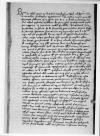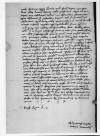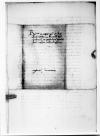In tribus causis, quas ill(ustris) ⌊princeps⌋ sollicitat, Dominatio Vestra Reverendissima per reverendos et venerabiles dominos visitatores consilium nostrum postulat, videlicet de permissione instagnationis piscinae per aggerem in territorio ⌊ecclesiae⌋ fundandum, prohibitione usus bombardarum in silvis et de servandis provincialibus statutis praescriptis, de servitiis praeterea suo nomine, an iuramentum per Dominationem Vestram Reverendissimam ⌊regiae maiestati⌋ sit praestandum denuo.
Quod ad aggerem attinet, videtur nobis causa magni ponderis esse, quo fit, ut consilia nostra sine longa procrastinatione Dominationi Vestrae Reverendissimae communicanda censuerimus, praesertim quod intelligamus eam ill(ustri) ⌊principi⌋ diem iam designasse, quo utrimque ad conspiciendum locum conveniatur. Quod si mutari non poterit, non parvam ansam hinc accipiet ⌊princeps⌋ vehementius per nuntios suos (ut sunt homines illi industrii et promptae linguae) urgendi et persuadendi, ut impetret, quod per ⌊praecessorem⌋ Dominationis Vestrae Reverendissimae nostro accedente consilio magnis causis olim negatum est. Si autem votis non respondebitur, parum aequis animis discedetur resque magis apud ⌊principem⌋ per eosdem nuntios graviter ferentes se non impetrasse, quod speraverant, exasperabitur.
Proinde nobis consultum videtur, ut Dominatio Vestra Reverendissima, quamprimum commode poterit, seorsum suos officiales ad locum illum mittat, qui eius situm et omnem condicionem diligenter explorent et habitatores oppidi ⌊Bischofstein⌋[1] ac alios accolas, praesertim peritiores, percontentur, quid incommodi aut futuri periculi sibiipsis aut dominio ex huiusmodi instagnatione immineat, et collectis cum ex ea lustratione, tum etiam ex litteris ⌊praecessoris⌋ sui et aliis in hoc negotio actis, quae adhuc in recenti memoria priorum officialium esse non dubitamus, causis, quibus merito desiderata negari possint, ⌊principi⌋ rescribat et, si fieri potest, anteaquam in diem designatum consentiat, se diligenti inquisitione rem explorasse ac certo didicisse, eam instagnationem citra magnum incommodum ac perniciem accolarum instagnandi rivuli fieri minime posse non modo ob eruptionis periculum, sed quod etiam piscinae exoneratio citra detrimentum circumiacentium pratorum et agrorum, quos effusae aquae eluere solent, etiamsi parum de fundo ⌊ecclesiae⌋ instagnaturae sint retrorsum coactae. Cum tamen fama sit magnam terrae partem huiusmodi instagnatione decessuram. Praeterea Reverendissima Dominatio Vestra expendere dignabitur, etsi id ⌊principi⌋ non scribet, quam periculosum sit fines ditionis ⌊ecclesiae⌋ tam solemniter constitutos, utcumque  AAWO, ABD, 122, f. 13v de indemnitate cautio praestetur et quantumvis parum fuerit mutare aut aliquid innovare.
AAWO, ABD, 122, f. 13v de indemnitate cautio praestetur et quantumvis parum fuerit mutare aut aliquid innovare.
Alias causas Dominatio Vestra Reverendissima pro sua prudentia producet, sed potissimas dumtaxat, et quibus contradici non facile possit, ne longe disputationi in ipsis refellendis detur occasio, et ne quid assequatur ex litteris, quod in suum commodum (ut fieri assolet) rapere queat ⌊princeps⌋ rogabitque, ut eius illustritas aequo ferat animo, quod Dominatio Vestra Reverendissima hac in re ei non obsequatur, quam non negandi studio, sed causae difficultate videt se non posse praestare in aliis sua exhibenda officia. Ex qua causa renuntiandi diei ad conveniendum constitutae occasio sumetur, ne frustra suos nuntios ⌊princeps⌋ fatiget, non fuisse Dominationem Vestram Reverendissimam, cum diem statuerit de causae condicione satis instructa etc.
Verumtamen studiose rogamus, ut caute omnia, quemadmodum nunc, ita et in posterum, sine venerabilis ⌊capituli⌋ mentione fiant, ne qui consultores Reverendissimae Dominationis Vestrae simus, rerum auctores indicemur.
Usum vero bombardarum in silvis placeret iuxta constitutionum publicarum decreta abrogari ideoque hoc rescribendum esse putamus. Si ipse ⌊princeps⌋ cum ⌊nobilitate et aliis subditis suis⌋ pariter abstinere vellet, libenter Dominationem Vestram Reverendissimam se confirmaturam.
De servitiis vero non satis intelligimus, quae statuta servari velit. Sunt enim plurima iam saepe facta et refecta, et eorum prope nihil observatum ullibi, pleraque etiam talia, quae (ut res ipsa docet) nequaquam observari possunt, nisi tota ⌊Prussia⌋ observanda susceperit. Si quid vero cerneret ⌊princeps⌋, quod de his et aliis rebus perpetuo tenore constans et durabile denuo, si non per ⌊totam patriam⌋, adminus inter ⌊Ducatum⌋ et ⌊ecclesiam⌋, ad conservandam bonam vicinitatem statui utiliter posset, non refragaturam se Dominationem Vestram Reverendissimam, quominus communiter per commoditatem hac de re tractetur et concors observantia utrobique statuatur. Quandoquidem constitutiones in ⌊Bartenstein⌋ conditae per felicis recordationis ⌊Mauritii⌋ praecessoris Dominationis Vestrae Reverendissimae mortem sublatae sunt, communes vero ⌊totius patriae⌋ per interpositas in fine protestationes et contrario usu etiam abrogatae censentur, aut verius receptae non fuerunt. Proinde etiam non videmus, quomodo obsoletis nos urgere possit ⌊princeps⌋, nisi rogentur novae. Quas si citra animorum acerbitatem declinare posset servitiis, longe consultius esse indicaremus, ut aut prorsus nullis, aut certe quam paucissimis irretiremur.
Quandoquidem magno nostro  AAWO, ABD, 122, f. 14r malo hactenus experti sumus, quid huiusmodi leges inter has ⌊duas solas ditiones⌋ decretae nobis profuerint. Quis enim ⌊principem⌋ aut nobilitarem ordinem non observantem placita coget? Quis observare se asserentem arguet, etiamsi nec minimum omnium observetur? Quid denique nobis patrocinabitur, si nos ad servandum recepta nihilominus urgebit ⌊ipse⌋, quemadmodum facere consuevit, nunc quoque etiam abolitis constitutionibus facit. ⌊Subditi⌋ praeterea ecclesiae, si in ⌊Ducatu⌋ transgressi fuerint, certa sunt praeda praefectis nec, nobis suffragantibus, quavis ratione eripi possunt. Econtra vero ⌊principis⌋ ⌊subditi⌋ in ⌊ecclesiae⌋ ditione delinquentes magnum habent patronum principem, cui citra incommodum negari prope nihil licet. Si tamen ad aliquod denuo statuens necessitas coegeret, magna deliberatione opus erit, ad quam ut Dominatio Vestra Reverendissima duos ex ⌊gremio capitulari⌋ ad se advocet, cum quibus de his rebus consilia communicet, necessarium fore existimamus.
AAWO, ABD, 122, f. 14r malo hactenus experti sumus, quid huiusmodi leges inter has ⌊duas solas ditiones⌋ decretae nobis profuerint. Quis enim ⌊principem⌋ aut nobilitarem ordinem non observantem placita coget? Quis observare se asserentem arguet, etiamsi nec minimum omnium observetur? Quid denique nobis patrocinabitur, si nos ad servandum recepta nihilominus urgebit ⌊ipse⌋, quemadmodum facere consuevit, nunc quoque etiam abolitis constitutionibus facit. ⌊Subditi⌋ praeterea ecclesiae, si in ⌊Ducatu⌋ transgressi fuerint, certa sunt praeda praefectis nec, nobis suffragantibus, quavis ratione eripi possunt. Econtra vero ⌊principis⌋ ⌊subditi⌋ in ⌊ecclesiae⌋ ditione delinquentes magnum habent patronum principem, cui citra incommodum negari prope nihil licet. Si tamen ad aliquod denuo statuens necessitas coegeret, magna deliberatione opus erit, ad quam ut Dominatio Vestra Reverendissima duos ex ⌊gremio capitulari⌋ ad se advocet, cum quibus de his rebus consilia communicet, necessarium fore existimamus.
Postremum, quod Dominatio Vestra Reverendissima suo nomine de iuramenti praestatione in consultationem adducit, non arbitramur, quod ⌊regia maiestas⌋ aliud sit exactura, quam in consilium praestari solitum, cum nec felicis recordationis ⌊Mauritium⌋, nec ⌊Fabianum⌋ praecessores Reverendissimae Dominationis Vestrae aliud praestitisse constat, de ⌊Luca⌋ autem nihil certi habemus. Sed quia huiuscemodi iusiurandum Dominatio Vestra Reverendissima dum a secretis esse inciperet, et fortassis etiam secundo, in adeptione ⌊episcopatus Culmensis⌋, praestitit, non videmus, cur idem nunc tertio contra veterem observantiam ⌊Regni⌋, quae eidem Reverendissimae Dominationi Vestrae magis quam nobis cognita est, iterari debeat, aut sine contemptu sacramenti ac divini nominis contumelia possit. Si autem aliud urgebitur, poterit Dominatio Vestra Reverendissima praecessores suos opponere et ea ratione se tueri.
Haec est in causis praemissis capitularis consultationis deliberatio nostra, quam et Reverendissima Dominatio Vestra boni consulat, rogamus.
Cui nos cum obsequiis nostris diligenter commendamus ac omnia fausta et laeta precamur.
 AAWO, ABD, 122, f. 13v de indemnitate cautio praestetur et quantumvis parum fuerit mutare aut aliquid innovare.
AAWO, ABD, 122, f. 13v de indemnitate cautio praestetur et quantumvis parum fuerit mutare aut aliquid innovare. AAWO, ABD, 122, f. 14r malo hactenus experti sumus, quid huiusmodi leges inter has
AAWO, ABD, 122, f. 14r malo hactenus experti sumus, quid huiusmodi leges inter has 


